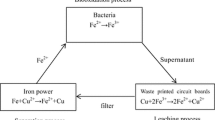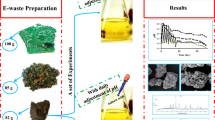Abstract
The goal of this study is to determine the potential of Acidithiobacillus ferrooxidans strain Z1 in bioleaching of metal concentrates of waste printed circuit boards (PCBs). The influences of initial pH, initial Fe(II) concentration, metal concentrates dosage, inoculation quantity and particle size on the bioleaching process were investigated and optimum conditions were determined. The results showed that 92.57 % copper leaching efficiency was achieved within 78 h in a two-step process, and 85.24 % aluminum and 95.18 % zinc were leached out after 183 h under the optimum conditions of initial pH 2.25, initial Fe(II) 9 g/L, metal concentrates dosage 12 g/L, inoculation quantity 10 % and particle size 0.178–0.250 mm. It demonstrated that metals could be efficiently leached from metal concentrates by Acidithiobacillus ferrooxidans Z1 and the bioleaching period was reduced 81–78 h. Therefore, the strain Acidithiobacillus ferrooxidans Z1 could be suggested as a potential strain to bioleach metals from metal concentrates of waste PCBs.







Similar content being viewed by others
References
Watling HR (2006) The bioleaching of sulphide minerals with emphasis on copper sulphides—a review. Hydrometallurgy 84(1–2):81–108
Bayat B, Sari B (2010) Comparative evaluation of microbial and chemical leaching processes for heavy metal removal from dewatered metal plating sludge. J Hazard Mater 174(1):763–769
Gu X, Wong JW (2004) Identification of inhibitory substances affecting bioleaching of heavy metals from anaerobically digested sewage sludge. Environ Sci Technol 38(10):2934–2939
Wu HY, Ting YP (2006) Metal extraction from municipal solid waste (MSW) incinerator fly ash—Chemical leaching and fungal bioleaching. Enzyme Microb Technol 38(6):839–847
Kumar RN, Nagendran R (2007) Influence of initial pH on bioleaching of heavy metals from contaminated soil employing indigenous Acidithiobacillus thiooxidans. Chemosphere 66(9):1775–1781
Zagury GJ, Narasiah KS, Tyagi RD (1994) Adaptation of indigenous iron-oxidizing bacteria for bioleaching of heavy metals in contaminated soils. Environ Technol 15(6):517–530
Chen SY, Lin JG (2001) Bioleaching of heavy metals from sediment: significance of pH. Chemosphere 44(5):1093–1102
Chen SY, Lin JG (2004) Bioleaching of heavy metals from contaminated sediment by indigenous sulfur-oxidizing bacteria in an air-lift bioreactor: effects of sulfur concentration. Water Res 38(14):3205–3214
Cerruti C, Curutchet G, Donati E (1998) Bio-dissolution of spent nickel–cadmium batteries using Thiobacillus ferrooxidans. J Biotechnol 62(3):209–219
Mishra D, Kim DJ, Ralph D, Ahn JG, Rhee YH (2008) Bioleaching of metals from spent lithium ion secondary batteries using Acidithiobacillus ferrooxidans. Waste Manag 28(2):333–338
Xin B, Zhang D, Zhang X, Xia Y, Wu F, Chen S, Li L (2009) Bioleaching mechanism of Co and Li from spent lithium-ion battery by the mixed culture of acidophilic sulfur-oxidizing and iron-oxidizing bacteria. Bioresour Technol 100(24):6163–6169
Zhu N, Zhang L, Li C, Cai C (2003) Recycling of spent nickel–cadmium batteries based on bioleaching process. Waste Manag 23(8):703–708
Brandl H, Bosshard R, Wegmann M (2001) Computer-munching microbes: metal leaching from electronic scrap by bacteria and fungi. Hydrometallurgy 59(2):319–326
Ilyas S, Anwar MA, Niazi SB, Afzal Ghauri M (2007) Bioleaching of metals from electronic scrap by moderately thermophilic acidophilic bacteria. Hydrometallurgy 88(1):180–188
Yang T, Xu Z, Wen J, Yang L (2009) Factors influencing bioleaching copper from waste printed circuit boards by Acidithiobacillus ferrooxidans. Hydrometallurgy 97(1):29–32
Zhu N, Xiang Y, Zhang T, Wu P, Dang Z, Li P, Wu J (2011) Bioleaching of metal concentrates of waste printed circuit boards by mixed culture of acidophilic bacteria. J Hazard Mater 192(2):614–619
Wang J, Xu J (2004) Environmental implications of PCB manufacturing in China, Electronics and the Environment, 2004 Conference Record 2004 IEEE International Symposium on, 156–158
Li J, Lu H, Guo J, Xu Z, Zhou Y (2007) Recycle technology for recovering resources and products from waste printed circuit boards. Environ Sci Technol 41(6):1995–2000
Ludwig C, Hellweg S, Stucki S (2002) Municipal solid waste management
Leung AO, Duzgoren-Aydin NS, Cheung K, Wong MH (2008) Heavy metals concentrations of surface dust from e-waste recycling and its human health implications in southeast China. Environ Sci Technol 42(7):2674–2680
Musson SE, Vann KN, Jang YC, Mutha S, Jordan A, Pearson B, Townsend TG (2006) RCRA toxicity characterization of discarded electronic devices. Environ Sci Technol 40(8):2721–2726
Shen C, Huang S, Wang Z, Qiao M, Tang X, Yu C, Shi D, Zhu Y, Shi J, Chen X (2007) Identification of Ah receptor agonists in soil of e-waste recycling sites from Taizhou area in China. Environ Sci Technol 42(1):49–55
Liang G, Mo Y, Zhou Q (2010) Novel strategies of bioleaching metals from printed circuit boards (PCBs) in mixed cultivation of two acidophiles. Enzyme Microb Technol 47(7):322–326
Xiang Y, Wu P, Zhu N, Zhang T, Liu W, Wu J, Li P (2010) Bioleaching of copper from waste printed circuit boards by bacterial consortium enriched from acid mine drainage. J Hazard Mater 184(1):812–818
Nie H, Yang C, Zhu N, Wu P, Zhang T, Zhang Y, Xing Y (2015) Isolation of Acidithiobacillus ferrooxidans strain Z1 and its mechanism of bioleaching copper from waste printed circuit boards. J Chem Technol Biotechnol 90(4):714–721
Visca P, Bianchi E, Polidoro M, Buonfiglio V, Valenti P, Orsi N (1989) A new solid medium for isolating and enumerating Thiobacillus ferrooxidans. J Gen Appl Microbiol 35(2):71–81
Stott M, Watling H, Franzmann P, Sutton D (2000) The role of iron-hydroxy precipitates in the passivation of chalcopyrite during bioleaching. Miner Eng 13(10):1117–1127
Ballor NR, Nesbitt CC, Lueking DR (2006) Recovery of scrap iron metal value using biogenerated ferric iron. Biotechnol Bioeng 93(6):1089–1094
Choi MS, Cho KS, Kim DS, Kim DJ (2004) Microbial Recovery of Copper from Printed Circuit Boards of Waste Computer by Acidithiobacillus ferrooxidans. J Environ Sci Health A 39(11–12):2973–2982
Marhual N, Pradhan N, Kar R, Sukla L, Mishra B (2008) Differential bioleaching of copper by mesophilic and moderately thermophilic acidophilic consortium enriched from same copper mine water sample. Bioresour Technol 99(17):8331–8336
Nemati M, Lowenadler J, Harrison S (2000) Particle size effects in bioleaching of pyrite by acidophilic thermophile Sulfolobus metallicus. Appl Microbiol Biotechnol 53(2):173–179
Wang J, Bai J, Xu J, Liang B (2009) Bioleaching of metals from printed wire boards by Acidithiobacillus ferrooxidans and Acidithiobacillus thiooxidans and their mixture. J Hazard Mater 172(2–3):1100–1105
Liang G, Tang J, Liu W, Zhou Q (2013) Optimizing mixed culture of two acidophiles to improve copper recovery from printed circuit boards (PCBs). J Hazard Mater 250–251(4):238–245
Acknowledgments
This work was financially supported by National Natural Science Foundation of China (51178191) and Program for New Century Excellent Talents in University (NCET-11-0166).
Author information
Authors and Affiliations
Corresponding author
Rights and permissions
About this article
Cite this article
Yang, C., Zhu, N., Shen, W. et al. Bioleaching of copper from metal concentrates of waste printed circuit boards by a newly isolated Acidithiobacillus ferrooxidans strain Z1. J Mater Cycles Waste Manag 19, 247–255 (2017). https://doi.org/10.1007/s10163-015-0414-7
Received:
Accepted:
Published:
Issue Date:
DOI: https://doi.org/10.1007/s10163-015-0414-7




